Abstract
Background: Mandibular advancement devices for obstructive sleep apnea treatment are becoming increasingly popular among patients who do not prefer CPAP devices or surgery. Our study aims to evaluate the literature regarding potential dental and skeletal side effects caused by mandibular advancement appliances used for adult OSA treatment. Methods: Electronic databases were searched for published and unpublished literature along with the reference lists of the eligible studies. Randomized clinical trials and non-randomized trials assessing dental and skeletal changes by comparing cephalometric radiographs were selected. Study selection, data extraction, and risk of bias assessment were performed individually and in duplicate. Fourteen articles were finally selected (two randomized clinical trials and 12 non-randomized trials). Results: The results suggest that mandibular advancement devices used for OSA treatment increase the lower incisor proclination by 1.54 ± 0.16°, decrease overjet by 0.89 ± 0.04 mm and overbite by 0.68 ± 0.04 mm, rotate the mandible downward and forward, and increase the SNA angle by to 0.06 ± 0.03°. The meta-analysis revealed high statistical heterogeneity. Conclusions: The MADs affect the lower incisor proclination, overjet, overbite, the rotation of the mandible and the SNA angle. More randomized clinical trials providing high-quality evidence are needed to support those findings.
1. Introduction
Obstructive sleep apnea syndrome (OSAS) is a sleep breathing disorder characterized by a periodic collapse of the upper airway during sleep. OSAS is diagnosed when there are five or more obstructive respiratory events per hour of sleep and signs/symptoms (i.e., snoring, and daytime sleepiness) or related medical/psychiatric disorders (i.e., hypertension). A sleep breathing disorder can also be considered as obstructive sleep apnea when 15 or more respiratory events occur in an hour of sleep without any signs/symptoms or disorders []. Although snoring is its primary symptom, some patients have less than five respiratory events per hour of sleep, and thus they are considered non-apnoeic snorers []. Respiratory events include obstructive and mixed apneas, hypopneas, and respiratory effort-related arousals, according to the American Academy of Sleep Medicine (AASM).
OSAS prevalence is high in adults, as it is thought to affect 14% of men and 5% of women. Its consequences, such as cardiovascular conditions, neurocognitive and mental health problems, decrease patients’ quality of life and can be lethal in some cases [,,,].
OSAS therapies include conservative measures (i.e., weight loss, better sleeping position, and alcohol avoidance), upper airway surgery, nasal continuous positive airway pressure (CPAP), and oral appliances []. Although CPAP, a device that continuously pressures the upper airway and prevents its collapse during sleep, is considered the gold standard for obstructive sleep apnea (OSA) treatment, oral appliances can be used as an alternative, and are often preferred by the patients. Oral appliances (OAs) are also proposed for apnoeic patients with intolerance to CPAP or non-apnoeic snorers who have failed conservative lifestyle changes (i.e., weight loss) [].
Nearly 100 different oral appliances are currently available, and they can be divided into three main groups: mandibular advancement devices (MADs), tongue retaining devices (TRD), and soft palate lifting devices. All of them intend to maintain the airway open, preventing its collapse. MADs which are the most commonly used, advance the mandible in order to increase the airway space and reduce pharyngeal collapsibility [].
Custom, titratable MADs are the most effective OAs for OSAS and snoring, according to the AASM. These MADs can reduce the apnea-hypopnea index (AHI), oxygen desaturation, arousal index, and increase oxygen saturation, although to a lower extent than CPAP in patients with OSAS. On the other hand, they have equivalent effectiveness compared with CPAP in the reduction in daytime sleepiness and hypertension and quality of life improvement. Furthermore, they have greater device adherence and less possibility of treatment discontinuation due to side effects (odds ratio of discontinuation of treatment due to the use of an OA vs. CPAP: 0.54:1). These oral appliances can also be useful in primary snoring, as they improve sleep quality and quality of life (QOL) and reduce snoring frequency and intensity [,].
In the past decades, many studies have examined the adverse effects of oral appliance use in OSAS/snoring treatment. These include subjective side effects, such as mouth dryness and temporomandibular dysfunction, examined through questionnaires and objective side effects assessed by dental casts and cephalometric analysis [,].
To our knowledge, there are some literature reviews, assessing the dental and skeletal side effects of mandibular protruding devices for the treatment of adult obstructive sleep apnea and snoring. In 2004, Hoekema et al. stated that there were predominantly occlusal changes, but they could not conclude about long term side effects []. More recently, Araie et al. (2018) found significant dental changes, regarding overjet and overbite decrease and lower incisor axis-mandibular plane angle (L1-MP) increase, but no skeletal changes []. Patel et al. (2019) also reported that there was a significant reduction in overjet and overbite []. On the other hand, Bartolucci et al. (2019) were the first to report significant skeletal changes in point A-nasion-point Β angle (ANB) and anterior facial height, except for dental changes in overjet, overbite, and incisor inclination []. Moreover, Mendes Martins et al. (2019) concluded that there were mainly long-term dental changes. The treatment duration and the population sample in some of the included studies for these reviews were small []. Furthermore, a cephalometric analysis, for assessing skeletal changes was not performed in all their included studies. A cephalometric analysis is based on the lateral X-ray tracing anatomic landmarks. The angles of these anatomic landmarks can conclude in valuable and accurate information for the skeletal and dental changes. Some of the most important landmarks for this research are the SNA angle that refers to the relationship of maxilla to the cranial base, the SNB angle that reveals the relationship of mandible to the cranial base, the ANB that refers to the relationship between maxilla and mandible, and the L1-MP angle that refers to the angulation of the lower incisors to the mandibular plane.
Our study aims to systematically review the most up-to-date scientific literature related with dental and skeletal changes caused by mandibular advancement devices used for the adult OSAS/snoring treatment, and perform a meta-analysis, in order to strengthen the current knowledge and help sleep physicians and qualified dentists/orthodontists to improve treatment’s efficacy and prevent discontinuation due to side effects.
2. Materials and Methods
2.1. Protocol and Registration
The protocol for this present systematic review was registered on the National Institute of Health Research Database (Protocol: CRD42020169736).
2.2. Eligibility Criteria
The following selection criteria were applied for the review:
- Study design: randomized clinical trials (RCTs), quasi-randomized clinical trials, and non-randomized prospective and retrospective trials (non-RCTs), without any restriction in language and time of publication, were considered eligible for inclusion in this review;
- Participants: adult patients with obstructive sleep apnea syndrome or snoring;
- Interventions: studies that treated obstructive sleep apnea and/or snoring patients with an oral appliance that protruded the mandible forward;
- Comparisons: comparisons were made between baseline and follow-up patient characteristics;
- Outcomes measures: any objective dental and skeletal change, in the treated patients.
2.3. Information Sources, Search Strategy and Study Selection
A literature search was carried out in the following electronic databases: Medline database (via PubMed), Embase (via Ovid), Scopus, CENTRAL, Google Scholar, and the Cochrane Oral Health Group’s Trial Register. Language restrictions were not applied. Unpublished literature was searched on ClinicalTrials.gov (accessed on 24 February 2022) and the National Research Register. The Medical Subject Heading (MeSH) terms used for this study were “sleep apnea syndromes”, “adverse effects”, “jaw”, and “tooth”. Conference proceedings and abstracts were also accessed when possible. The authors were contacted to identify unpublished or ongoing clinical trials and to clarify data as required. Reference lists of the included studies were screened for relevant research. Finally, hand-searching was performed. The search strategy for PubMed is presented in Table 1.

Table 1.
The search strategy for PubMed. Abbreviations: Mesh—Medical Subject Headings.
Studies were selected independently and in duplicate by two authors (I.A.T., S.M.). Any inconsistencies were resolved by discussion with the other two authors (J.M.P., A.I.T.). They were not blinded while identifying the authors of the studies, their institutions, or their research findings. After the identification of potentially relevant studies by title, abstracts were read, and non-eligible studies were eliminated. After this stage, hand-searching of the references of the eligible studies was performed to find additional articles, which were not previously found. Finally, after reading the articles in full, the choice was made according to our inclusion and exclusion criteria (Table 2).

Table 2.
Inclusion and exclusion criteria.
2.4. Data Items and Collection Extraction and Management
Two review authors (I.A.T., S.M.) performed data extraction independently and in duplicate. The information that was extracted included participants, intervention/appliance, treatment duration/observational period, outcomes, methods of outcome assessment, results, and conclusions. In case of no access to the missing data, only the existing data were reported and analyzed.
2.5. Risk of Bias/Quality Assessment in Individual Studies
The quality assessment of the included studies was performed using the ACROBAT-NRSI tool of Cochrane for non-randomized clinical trials and the Cochrane handbook for systematic reviews (chapter 8) for randomized clinical trials. Two review authors (I.A.T., S.M.) assessed the articles individually and then compared their findings. Any disagreements were resolved by discussion with the other two authors (J.M.P., A.I.T.). Regarding the randomized clinical trials, seven domains of bias were assessed: random sequence generation, allocation concealment, performance bias, detection bias, attrition bias, bias due to selective outcome reporting, and other sources of bias. A judgment of ‘low’, ‘high’, or ‘unclear’ risk of bias was made for each domain, while a final overall judgment was assessed based on the following:
- Low risk of bias if all key domains of the study were at low risk of bias;
- Unclear risk of bias if one or more key domains of the study were unclear;
- High risk of bias if one or more key domains were at high risk of bias.
Concerning the non-randomized trials, bias due to confounding, bias in the selection of participants, bias in the measurement of interventions, bias due to departures from intended interventions, bias due to missing data, bias in the measurement of outcomes, and bias in the selection of the reported result were assessed for the qualitative evaluation of the study. Possible results for each domain and hence the overall evaluation of each study was: ‘low’, ‘moderate’, ‘serious’ risk of bias, and ‘no information’. We used the GRADE approach to interpret the results of this review.
2.6. Additional Analyses
Meta-analyses were undertaken using individual results on the change from the baseline in the parameters under study. They were summarized over all studies providing appropriate statistics (i.e., standard error/deviation for the change or p-value from a parametric test) using fixed or random-effects meta-analysis. Heterogeneity between studies was assessed using I2, and in the presence of significant heterogeneity, a random-effects model was used []. Stata command, metan, in Stata v13 was used for the analysis (StataCorp. 2013. Stata Statistical Software: Release 13. College Station, TX, USA: StataCorp LP).
3. Results
3.1. Study Selection and Characteristics
Our search resulted in 2297 articles. After title and abstract reading, irrelevant articles and duplicates were excluded, and 155 articles were read in full. Finally, 14 articles were selected for final analysis (two RCTs and 12 non-RCTs), based on our inclusion/exclusion criteria (Table 1) [,,,,,,,,,,,,,]. The procedure of article selection is presented on a flow diagram (Figure 1), and data are briefly presented in Table 3.
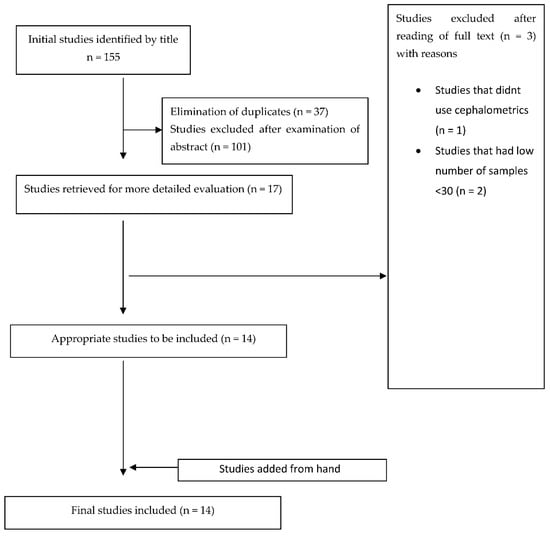
Figure 1.
Flow diagram, selection of studies.

Table 3.
Data extraction.
3.2. Risk of Bias within Studies
The seven criteria for the RCT bias assessment were random sequence generation, allocation concealment, performance bias, detection bias, attrition bias, selective reporting, and additional bias. One of the RCTs presented low risk of bias in all seven criteria, while the other study presented serious risk of bias due to random sequence generation, allocation concealment, attrition bias, and additional bias (Table 4).

Table 4.
Risk of bias assessment for randomized clinical trials. Abbreviations: CPAP—continuous positive airway pressure, MAD(s)—mandibular advancement device(s), UPPP—uvulopalatopharyngoplasty.
The seven criteria for the non-RCT studies were: bias due to confounding, bias in the selection participants into the study, bias in the measurement of interventions, bias due to departures from intended interventions, bias due to missing data, bias in measurement outcomes and bias in the selection of the reported result. Seven studies presented a low risk of bias. None of the 12 studies showed bias in the selection of the reported result. One study presented a serious risk of bias due to confounding and in the measurement of intervention, while two studies presented a serious risk of bias due to confounding, in the selection of participants, in the measurement of intervention and the measurement of outcomes. Another study showed a serious risk of bias. Finally, one study presented bias in the selection of participants and the measurement of outcomes. Another study showed a serious risk of bias in five out of seven criteria. This study presented a serious risk of bias: due to confounding, in the selection of participants, in the measurement of intervention, due to missing data and in the measurement of outcomes (Table 5).

Table 5.
Risk of bias assessment for non-randomized controlled trials.
3.3. Results of Meta-Analysis
A meta-analysis was performed for the outcomes of sella-nasion-pointA angle (SNA), sella-nasion-pointB angle (SNB), ANB angle, overjet, overbite, and L1-MP angle. (Table 6) There was no significant heterogeneity in SNA results (I2 = 14.8%, p = 0.31). An overall statistically significant positive change from baseline was found in SNA when studies were combined: 0.06 with 95% confidence interval (CI) (0.007, 0.116) (Figure 2). The SNB results were heterogeneous (I2 = 90.8%, p < 0.001). Overall estimated change from baseline in SNB was not statistically significant (p = 0.436): −0.099 with 95% CI (−0.347, 0.150) (Figure 3). Furthermore, the ANB results were heterogeneous (I2 = 82.2%, p < 0.001). Overall estimated change from baseline in ANB was not statistically significant (p = 0.360): 0.09 with 95% CI (−0.107, 0.296) (Figure 4). Overjet results were also heterogeneous (I2 = 94.5%, p < 0.001). An overall statistically significant decrease compared with baseline was found in overjet when studies were combined: −0.89 with 95% CI (−1.334, −0.459) (Figure 5). Overbite results were also heterogeneous (I2 = 93.3%, p < 0.001). An overall statistically significant decrease compared with baseline was found in overjet when studies were combined: −0.68 with 95% CI (−1.016, −0.344) (Figure 6). Finally, heterogeneity was found in L1-MP, between studies (I2 = 96.9%, p < 0.001). An overall positive and statistically significant change from baseline was found in L1-MP when studies were combined: 2.97 with 95% CI (0.993, 4.954) (Figure 7).

Table 6.
Overall results of meta-analysis. Mean difference, upper limit, and standard deviation.
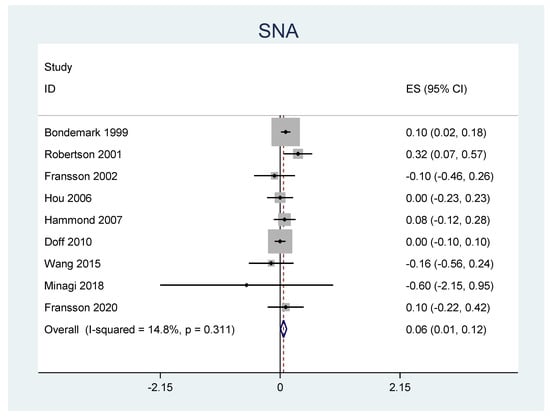
Figure 2.
Forest plot of the results of SNA changes using the random-effects model.
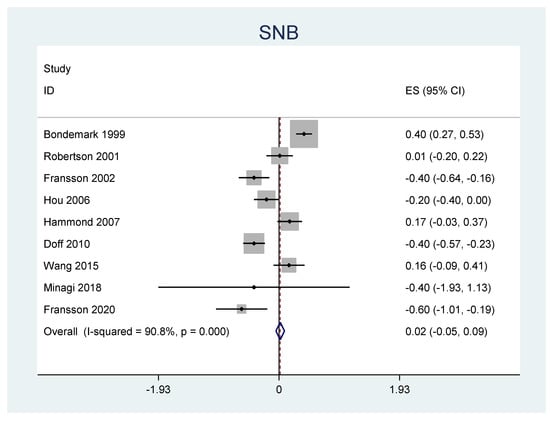
Figure 3.
Forest plot of the results of SNB changes using the random-effects model.
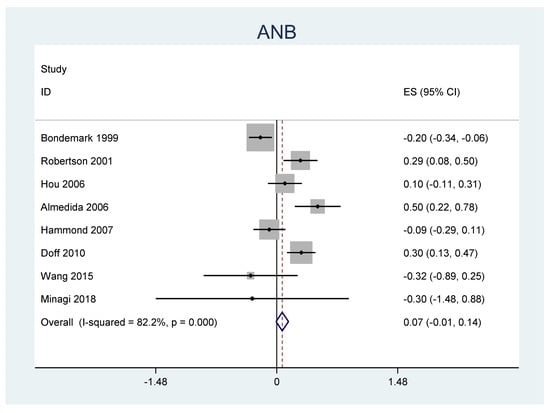
Figure 4.
Forest plot of the results of ANB changes using the random-effects model.
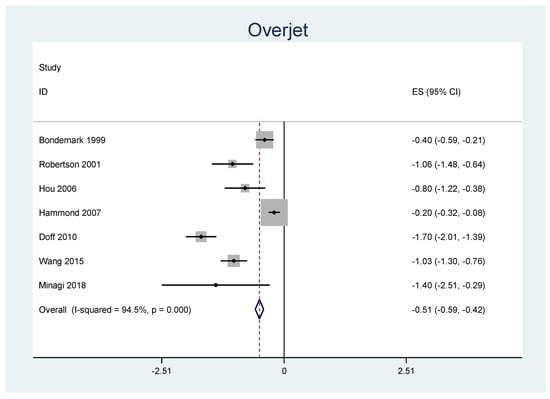
Figure 5.
Forest plot of the results of overjet changes using the random-effects model.
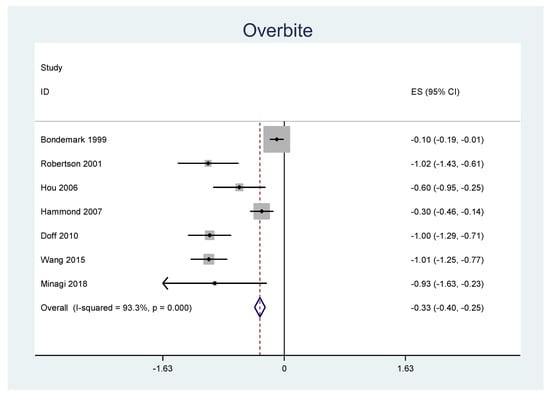
Figure 6.
Forest plot of the results of overbite changes using the random-effects model.
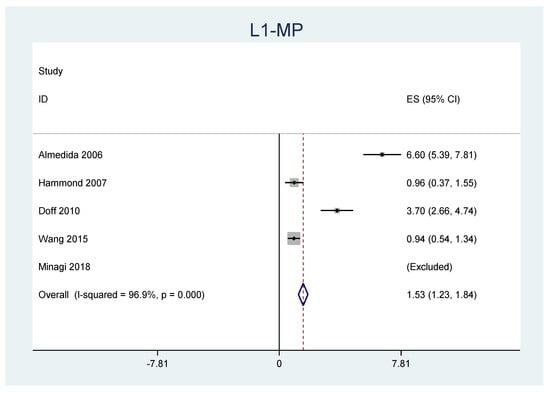
Figure 7.
Forest plot of the results of L1-MP changes using the random-effects model.
3.4. Dental Changes
Bondemark et al. found a reduction in overjet and overbite, but no significant changes in incisor inclination or interincisal angle []. A few years later, Rose et al. and Robertson et al. found that maxillary incisors were retroclined, mandibular incisors were proclined, and thus overjet and overbite were reduced [,,]. Still, according to Rose et al., the interincisal angle was not altered []. Conversely, Fransson et al. observed a reduction in the interincisal angle, because only the lower incisors were proclined, without a significant inclination change in upper incisors []. On the other hand, in the RCT of Ringqvist et al., incisor inclination changed only vertically, without any further alteration in overjet, overbite, and interincisal angle [].
In the following years, the studies of Almeida et al., Doff et al., and Wang et al. showed that both, proclination of lower incisors and retroclination of the upper incisors, led to overjet and overbite reduction [,,]. Moreover, Hou et al. found a decrease in overjet and overbite without examining incisor inclination, and Hammond et al. observed only upper incisor posterior tipping [,]. Although the interincisal angle was reduced, according to Almeida et al., Doff et al., and Hammond et al., it did not change significantly in Wang et al. study [,,,].
More recently, Minagi et al. showed a significant decrease in overjet and overbite because of mandibular incisor proclination, while the interincisal angle remained unchanged []. Furthermore, Hamoda et al. found that both upper and lower incisors were tipped backward and forward, respectively []. Finally, Fransson et al. observed overjet and overbite reduction due to altered inclination of upper and lower incisors, after 10 years of mandibular protruding device use [].
Regarding posterior teeth changes, Robertson et al. found that the upper first premolars and lower first molars had over-erupted while, Almeida et al. found that first upper and lowers molars, except from over-erupting, had also moved distally and mesially [,]. Moreover, Hammond et al. showed a mesial tip of the lower first molars, but without a change in the upper first molars [].
3.5. Skeletal Changes
Regarding changes in mandibular position relative to the cranial base, in most studies, the mandibular plane angle was significantly increased, and thus the mandible had a more downward position [,,,,,,,]. Bondemark found a more downward and forward position and Ringqvist et al. a more downward and backward position [,]. On the other hand, Rose et al., Hammond et al., and Minagi et al. found no significant changes in mandibular position [,,]. The vertical condylar position was also observed to be more downward by Robertson et al., but not in Almeida et al. study, in which there were no condylar changes [,]. Regarding the relation between the maxilla and the mandible and each jaw relationship with the cranial base, the ANB angle was found slightly reduced by Bondemark, because the SNB angle was increased, and the SNA angle did not change []. Robertson et al., also observed a decrease in ANB angle, because the SNA angle was reduced and SNB was not altered significantly []. On the other hand, the ANB angle was increased in the study by Hamoda et al., due to a decrease in the SNB angle and no significant change in the SNA angle []. Moreover, according to Doff et al., the ANB angle was increased, while the SNB angle was reduced, and the SNA angle did not change []. Conversely, some studies showed no significant change in the ANB angle [,,,,]. Furthermore, the SNB angle was found slightly reduced by Fransson et al. [,].
Alterations in facial height were also observed in many studies. An increase in lower anterior facial height and thus an increase in total anterior facial height was found by most researchers, except Minagi et al. that found no significant change [,,,,,,,,]. On the other hand, lower posterior facial height and total posterior facial height was found significantly increased only in two studies [,], while four other studies showed no significant change [,,,].
Bondemark also observed a significant increase in mandibular length []. On the contrary, a significant alteration in mandibular length was not found by others [,,,,,]. Although Fransson et al. did not find a significant change after 2 years of treatment, they observed a significant increase in patients that continued the treatment for 10 years as well as in patients that stopped the treatment [,].
The maxillary length was also increased in the studies by Robertson and Robertson et al. [,], but no significant change was observed in any other study [,,].
Frasson et al. also observed an alteration in the hyoid bone position. More specifically, the distance between the hyoid bone and mandibular plane and between the hyoid bone and occlusal line was increased []. Moreover, a more downward hyoid bone position was observed by Fransson et al. after 10 years of oral appliance use, but it was also evident in patients that had stopped using the device [].
4. Discussion
Summary of Evidence
Different outcomes were searched among studies, the quality of which was also variable, according to the risk of bias assessment.
The two existing RCT studies were reported in 2003 by Ringvist et al. and in 2010 by Doff et al. [,]. The study of Ringvist et al. in 2003 presented a high risk of attrition bias []. In this study, patients that used two different methods of treatment at the same time were included in the final sample. Furthermore, this study presented a high risk of bias due to additional bias. In the study, a high number of patients did not attend the 4-year follow-up (15 in the MAD group and 6 in the uvulopalatopharyngoplasty -UPPP- group). On the other hand, the study of Doff et al. appeared to have a low risk of bias in all seven criteria for the outcome assessment []. Consequently, the statement that the use of MAD appliances leads to a decrease in overjet and overbite as well as results in shorter a downward and backward rotation of the mandible considered conclusions with a high level of evidence.
Twelve non-RCT studies were reported for the assessment of dental and skeletal effects from the long-term use of mandibular advancement devices. The study of Hou et al. showed a serious risk of bias due to confounding and in the measurement of intervention []. More specifically, the intervention status was not well-defined, and there were patients that switched treatment, which was not adjusted in the final analysis. The study of Almeida et al. presented a serious risk of bias due to confounding, in the selection of participants, in the measurement of intervention and the measurement of outcomes []. In this study, the start and follow-up measurements did not coincide, and the intervention status was not well-defined. The study of Hamoda et al. showed a serious risk of bias in those three criteria as well []. The most important bias in this study was the absence of the intervention status regarding the usage frequency of the devices. Hammond et al. showed a serious risk of bias in five out of seven criteria []. This study presented a serious risk of bias: due to confounding, in the selection of participants, in the measurement of intervention, due to missing data and in the measurement of outcomes. According to this study, there were patients that switched treatment, there were missing data, and the outcome assessor was aware of the intervention received by the participants (not blinded). The study by Wang et al. showed a serious risk of bias in the selection of participants and the measurement of outcomes []. The method of outcome assessment was subjective.
The remaining seven studies showed a low risk of bias in all criteria. Bondemark found that the use of MADs appliances resulted in decreased overjet and overbite, increased mandibular length, and the mandible moved forward and downwards []. Robertson in 2001 showed decreased overjet and overbite, increased lower incisor proclination, SNA, and ANB []. Robertson et al. in 2003 found that the use of MAD appliances resulted in over eruption of upper first premolars and lower first molars and proclination of the lower incisors []. Rose et al. showed an increase in incisor inclination, a mesial shift of the occlusion, and a decreased overjet and overbite []. Fransson et al. in 2002 found an increase in the posterior rotation of the mandible as long as an increased proclination of the mandibular incisors []. The study of Minagi et al. resulted in decreased overjet and overbite []. In 2020 Fransson et al. concluded that the use of MADs resulted in proclination of the mandibular incisors with consequent decreased overjet and overbite []. All these statements are considered to be strong since those researches had a low risk of bias.
The heterogeneity was high for all the outcomes in this meta-analysis. A possible explanation for this might be the different treatment duration among the included studies. The mean treatment duration was less or equal to 3 years in most studies [,,,,,,,], 4 years for two studies [,], 7 years in one study [], and over 10 years in two studies [,].
Moreover, the design of the mandibular advancement devices was different in most of the studies [,,,,,,,,,,,,,]. All the oral appliances protruded the mandible and provided full occlusal coverage [,,,,,,,,,,,,], except for one that provided occlusal coverage only for the posterior teeth []. There was also variation in the amount of protrusion for each oral appliance. A 65–75% of the maximum protrusion with a small vertical opening was used in most studies [,,,,,,,,,,,,], but 50% of the maximum protrusion was chosen by one study []. In the study by Ringvist et al. that used the appliance that provided only posterior occlusal coverage and protruded the mandible, only 50% showed no change in overjet and overbite. On the other hand, a systematic review and meta-analysis found no significant difference between the side effects caused by 50% and 75% of maximum protrusion [].
Furthermore, adherence to the oral appliance daily wear might be a factor that increased outcome heterogeneity. All studies required the patients to wear the oral appliances at least 5 h a day and at least 4 days per week. The non-adherent patients were also excluded from all studies. Nevertheless, no objective method was used to record patient total wear time and thus evaluate true patient compliance.
Finally, one of the outcomes that was controversial is the extrusion of the molars as an effect of the MADs use. An explanation on that disagreement between the studies can be that MADs design differs on the occlusal coverage. More specific, the studies that used appliances with occlusal coverage could prevent dental extrusion while the ones that do not have the coverage could not. In the near future, 3D printing technology can be helpful in order to fabricate those appliances and possibly be delivered the same day to the patient’s mouth. There are lots of other appliances in the field of orthodontics that have been fabricated with 3D printing technology and proved to be significantly successful for the treatment outcome []. The limitation of this study is the small number of randomized clinical trials in the present literature.
5. Conclusions
Regarding dental and skeletal side effects caused by mandibular advancement appliances used for adult OSA treatment, the current level of evidence is weak. The meta-analysis results suggest that mandibular advancement devices used for OSA treatment increase the lower incisor proclination by 1.54 ± 0.16°, decrease overjet by 0.89 ± 0.04 mm, decrease overbite by 0.68 ± 0.04 mm, rotate the mandible downward and forward, and increase SNA angle by to 0.06 ± 0.03°. Some of those results are clearly not clinically significant. More randomized clinical trials providing high-quality evidence are needed.
Author Contributions
I.A.T., data curation, formal analysis, investigation, methodology, resources, software, validation, visualization, roles/writing—original draft; J.M.P., project administration, supervision, writing—review and editing; S.M., data curation, formal analysis, investigation, resources, writing—review and editing; A.I.T., conceptualization, methodology, project administration, supervision, validation, writing—review and editing. All authors have read and agreed to the published version of the manuscript.
Funding
This research received no external funding.
Institutional Review Board Statement
Not applicable.
Informed Consent Statement
Not applicable.
Data Availability Statement
Not applicable.
Conflicts of Interest
The authors declare no conflict of interest.
References
- Sateia, M.J. International classification of sleep disorders-third edition: Highlights and modifications. Chest 2014, 146, 1387–1394. [Google Scholar] [CrossRef] [PubMed]
- Koutsourelakis, I.; Perraki, E.; Zakynthinos, G.; Minaritzoglou, A.; Vagiakis, E.; Zakynthinos, S. Clinical and polysomnographic determinants of snoring. J. Sleep Res. 2012, 21, 693–699. [Google Scholar] [CrossRef]
- Tsolakis, I.A.; Venkat, D.; Hans, M.G.; Alonso, A.; Palomo, J.M. When static meets dynamic: Comparing cone-beam computed tomography and acoustic reflection for upper airway analysis. Am. J. Orthod Dentofac. Orthop. 2016, 150, 643–650. [Google Scholar] [CrossRef]
- Rohra, A.K., Jr.; Demko, C.A.; Hans, M.G.; Rosen, C.; Palomo, J.M. Sleep disordered breathing in children seeking orthodontic care. Am. J. Orthod Dentofac. Orthop. 2018, 154, 65–71. [Google Scholar] [CrossRef] [PubMed]
- Caples, S.M.; Gami, A.S.; Somers, V.K. Obstructive sleep apnea. Ann. Intern. Med. 2005, 142, 187–197. [Google Scholar] [CrossRef] [PubMed]
- Behrents, R.G.; Shelgikar, A.V.; Conley, R.S.; Flores-Mir, C.; Hans, M.; Levine, M.; McNamara, J.A.; Palomo, J.M.; Pliska, B.; Stockstill, J.W.; et al. Obstructive sleep apnea and orthodontics: An American Association of Orthodontists White Paper. Am. J. Orthod Dentofac. Orthop. 2019, 156, 13–28.e1. [Google Scholar] [CrossRef] [PubMed] [Green Version]
- Punjabi, N.M. The epidemiology of adult obstructive sleep apnea. Proc. Am. Thorac. Soc. 2008, 5, 136–143. [Google Scholar] [CrossRef] [PubMed]
- Williams, S.K.; Ravenell, J.; Jean-Louis, G.; Zizi, F.; Underberg, J.A.; McFarlane, S.I.; Ogedegbe, G. Resistant hypertension and sleep apnea: Pathophysiologic insights and strategic management. Curr. Diab. Rep. 2011, 11, 64–69. [Google Scholar] [CrossRef] [PubMed]
- Usmani, Z.A.; Chai-Coetzer, C.L.; Antic, N.A.; McEvoy, R.D. Obstructive sleep apnoea in adults. Postgrad. Med. J. 2013, 89, 148–156. [Google Scholar] [CrossRef]
- Ramar, K.; Dort, L.C.; Katz, S.G.; Lettieri, C.J.; Harrod, C.G.; Thomas, S.M.; Chervin, R.D. Clinical Practice Guideline for the Treatment of Obstructive Sleep Apnea and Snoring with Oral Appliance Therapy: An Update for 2015. J. Clin. Sleep Med. 2015, 11, 773–827. [Google Scholar] [CrossRef] [PubMed] [Green Version]
- Marklund, M.; Braem, M.J.A.; Verbraecken, J. Update on oral appliance therapy. Eur. Respir. Rev. 2019, 28, 190083. [Google Scholar] [CrossRef] [PubMed]
- Chen, A.; Burger, M.S.; Rietdijk-Smulders, M.A.W.J.; Smeenk, F.W.J.M. Mandibular advancement device: Effectiveness and dental side effects. A real-life study. Cranio 2020, 40, 97–106. [Google Scholar] [CrossRef] [PubMed]
- Hoekema, A.; Stegenga, B.; De Bont, L.G. Efficacy and co-morbidity of oral appliances in the treatment of obstructive sleep apnea-hypopnea: A systematic review. Crit Rev. Oral Biol. Med. 2004, 15, 137–155. [Google Scholar] [CrossRef] [PubMed]
- Araie, T.; Okuno, K.; Ono Minagi, H.; Sakai, T. Dental and skeletal changes associated with long-term oral appliance use for obstructive sleep apnea: A systematic review and meta-analysis. Sleep Med. Rev. 2018, 41, 161–172. [Google Scholar] [CrossRef] [PubMed]
- Patel, S.; Rinchuse, D.; Zullo, T.; Wadhwa, R. Long-term dental and skeletal effects of mandibular advancement devices in adults with obstructive sleep apnoea: A systematic review. Int. Orthod. 2019, 17, 3–11. [Google Scholar] [CrossRef] [PubMed]
- Bartolucci, M.L.; Bortolotti, F.; Martina, S.; Corazza, G.; Michelotti, A.; Alessandri-Bonetti, G. Dental and skeletal long-term side effects of mandibular advancement devices in obstructive sleep apnea patients: A systematic review with meta-regression analysis. Eur. J. Orthod. 2019, 41, 89–100. [Google Scholar] [CrossRef] [PubMed]
- Martins, O.F.M.; Chaves Junior, C.M.; Rossi, R.R.P.; Cunali, P.A.; Dal-Fabbro, C.; Bittencourt, L. Side effects of mandibular advancement splints for the treatment of snoring and obstructive sleep apnea: A systematic review. Dent. Press J. Orthod. 2018, 23, 45–54. [Google Scholar] [CrossRef]
- DerSimonian, R.; Laird, N. Meta-analysis in clinical trials. Control Clin. Trials 1986, 7, 177–188. [Google Scholar] [CrossRef]
- Bondemark, L. Does 2 years’ nocturnal treatment with a mandibular advancement splint in adult patients with snoring and OSAS cause a change in the posture of the mandible? Am. J. Orthod. Dentofac. Orthop. 1999, 116, 621–628. [Google Scholar] [CrossRef]
- Robertson, C.J. Dental and skeletal changes associated with long-term mandibular advancement. Sleep 2001, 24, 531–537. [Google Scholar] [CrossRef] [Green Version]
- Fransson, A.M.; Tegelberg, A.; Svenson, B.A.; Lennartsson, B.; Isacsson, G. Influence of mandibular protruding device on airway passages and dentofacial characteristics in obstructive sleep apnea and snoring. Am. J. Orthod. Dentofac. Orthop. 2002, 122, 371–379. [Google Scholar] [CrossRef] [PubMed]
- Rose, E.C.; Staats, R.; Virchow, C., Jr.; Jonas, I.E. Occlusal and skeletal effects of an oral appliance in the treatment of obstructive sleep apnea. Chest 2002, 122, 871–877. [Google Scholar] [CrossRef]
- Robertson, C.; Herbison, P.; Harkness, M. Dental and occlusal changes during mandibular advancement splint therapy in sleep disordered patients. Eur. J. Orthod. 2003, 25, 371–376. [Google Scholar] [CrossRef] [PubMed] [Green Version]
- Ringqvist, M.; Walker-Engström, M.L.; Tegelberg, A.; Ringqvist, I. Dental and skeletal changes after 4 years of obstructive sleep apnea treatment with a mandibular advancement device: A prospective, randomized study. Am. J. Orthod. Dentofac. Orthop. 2003, 124, 53–60. [Google Scholar] [CrossRef]
- Hou, H.M.; Sam, K.; Hägg, U.; Rabie, A.B.M.; Bendeus, M.; Yam, L.Y.C.; Ip, M.S. Long-term dentofacial changes in Chinese obstructive sleep apnea patients after treatment with a mandibular advancement device. Angle Orthod. 2006, 76, 432–440. [Google Scholar] [PubMed]
- Almeida, F.R.; Lowe, A.A.; Sung, J.O.; Tsuiki, S.; Otsuka, R. Long-term sequellae of oral appliance therapy in obstructive sleep apnea patients: Part 1. Cephalometric analysis. Am. J. Orthod. Dentofac. Orthop. 2006, 129, 195–204. [Google Scholar] [CrossRef] [PubMed]
- Hammond, R.J.; Gotsopoulos, H.; Shen, G.; Petocz, P.; Cistulli, P.A.; Darendeliler, M.A. A follow-up study of dental and skeletal changes associated with mandibular advancement splint use in obstructive sleep apnea. Am. J. Orthod. Dentofac. Orthop. 2007, 132, 806–814. [Google Scholar] [CrossRef]
- Doff, M.H.; Hoekema, A.; Pruim, G.J.; Huddleston Slater, J.J.; Stegenga, B. Long-term oral-appliance therapy in obstructive sleep apnea: A cephalometric study of craniofacial changes. J. Dent. 2010, 38, 1010–1018. [Google Scholar] [CrossRef] [Green Version]
- Wang, X.; Gong, X.; Yu, Z.; Gao, X.; Zhao, Y. Follow-up study of dental and skeletal changes in patients with obstructive sleep apnea and hypopnea syndrome with long-term treatment with the Silensor appliance. Am. J. Orthod. Dentofac. Orthop. 2015, 147, 559–565. [Google Scholar] [CrossRef] [PubMed]
- Minagi, H.O.; Okuno, K.; Nohara, K.; Sakai, T. Predictors of Side Effects with Long-Term Oral Appliance Therapy for Obstructive Sleep Apnea. J. Clin. Sleep Med. 2018, 14, 119–125. [Google Scholar] [CrossRef] [PubMed]
- Hamoda, M.M.; Almeida, F.R.; Pliska, B.T. Long-term side effects of sleep apnea treatment with oral appliances: Nature, magnitude and predictors of long-term changes. Sleep Med. 2019, 56, 184–191. [Google Scholar] [CrossRef]
- Fransson, A.M.C.; Benavente-Lundahl, C.; Isacsson, G. A prospective 10-year cephalometric follow-up study of patients with obstructive sleep apnea and snoring who used a mandibular protruding device. Am. J. Orthod. Dentofac. Orthop. 2020, 157, 91–97. [Google Scholar] [CrossRef] [PubMed]
- Sakamoto, Y.; Furuhashi, A.; Komori, E.; Ishiyama, H.; Hasebe, D.; Sato, K.; Yuasa, H. The Most Effective Amount of forwarding Movement for Oral Appliances for Obstructive Sleep Apnea: A Systematic Review. Int. J. Environ. Res. Public Health 2019, 16, 3248. [Google Scholar] [CrossRef] [PubMed] [Green Version]
- Thurzo, A.; Urbanová, W.; Novák, B.; Waczulíková, I.; Varga, I. Utilization of a 3D Printed Orthodontic Distalizer for Tooth-Borne Hybrid Treatment in Class II Unilateral Malocclusions. Materials 2022, 15, 1740. [Google Scholar] [CrossRef] [PubMed]
Publisher’s Note: MDPI stays neutral with regard to jurisdictional claims in published maps and institutional affiliations. |
© 2022 by the authors. Licensee MDPI, Basel, Switzerland. This article is an open access article distributed under the terms and conditions of the Creative Commons Attribution (CC BY) license (https://creativecommons.org/licenses/by/4.0/).